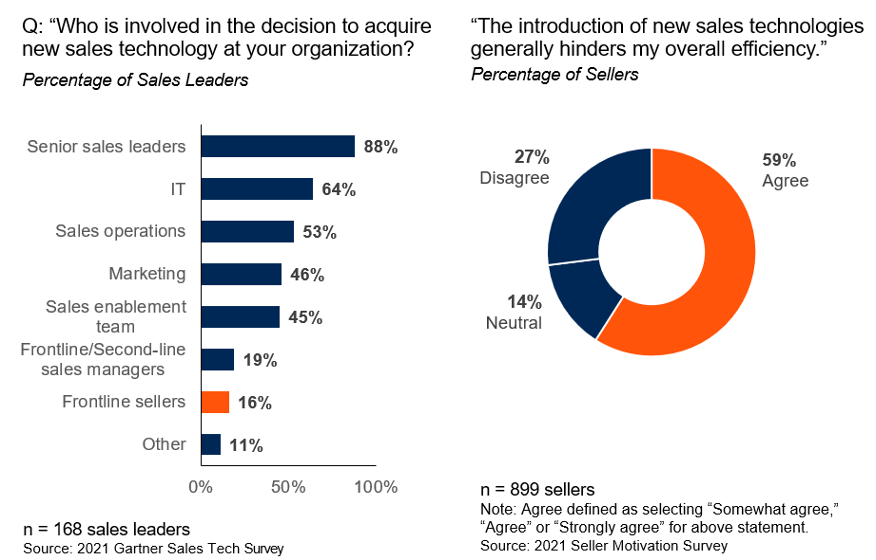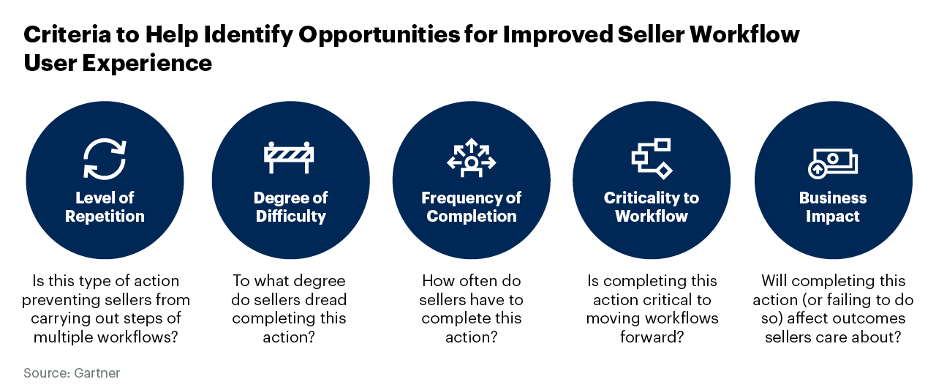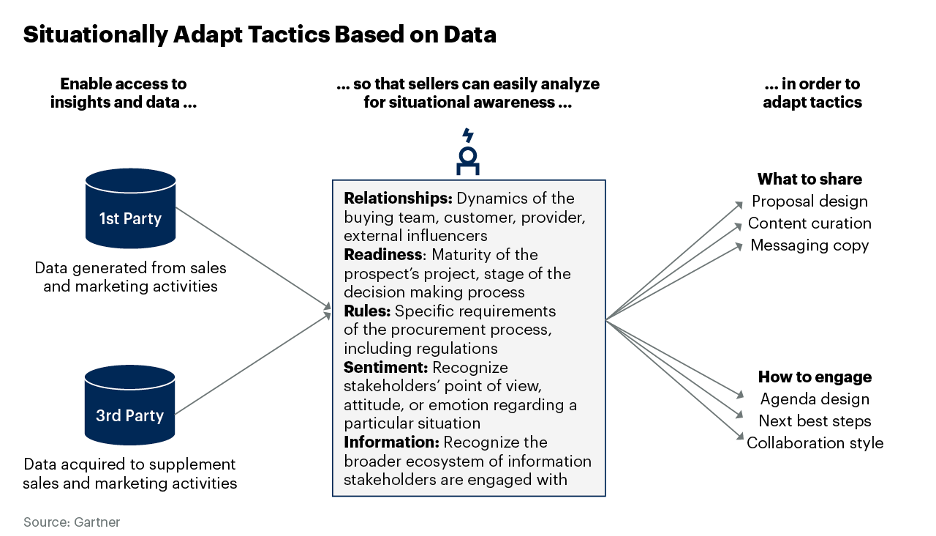
The curiosity, demand and innovation in sales tech are all pointing up and to the right. Gartner clients are curious to learn about new ways technology can help their sellers generate pipeline, run deals and be productive.
In the 2021 Gartner Sales Tech Survey, conducted online in November and December 2021 among 168 global respondents, 68% of sales leaders increased their total spend in their sales tech stack. Yet lingering in the back of many of their minds is the burning skepticism, an intuitive whisper: “Will my sellers adopt this?”
For a sales leader, ROI from a new investment is a pipedream without adoption from the frontline. Sellers are notoriously resistant to adopt technology provided by their employers. In Gartner’s 2021 Seller Motivation Survey, a majority of sellers noted the introduction of new tech hinders their overall efficiency (see below).

Sales leaders need a simple way to figure out which technologies sellers will actually use.
The best way to improve the probability of sales tech adoption is at the concept phase, before deciding which vendors to speak with. Below are five principles that sales leaders can use to help design concept statements detailing how tech may improve the daily reality of sellers.
Gartner recommends applying these principles to the three to five highest-impact anchor use cases in their sales process. The outcome of the exercise is often concept statements that sales leaders can then use to evaluate vendors with hyper-specific outcomes in mind.
Help Sellers Facilitate Compelling Buyer Engagement
Sellers need a facilitator toolkit and must “be everywhere” in a deal. A seller’s effective use of technology is the top factor in improving buyer confidence, and buyers are most likely to experience a seller’s use of technology via how buyers engage.
Enhancing both live meeting facilitation and asynchronous interaction points between buyers and sellers equips sellers with technology to provide collaborative and visual experiences and better enables them to win in virtual selling environments:
Live meeting collaboration – Design highly engaging experiences using virtual collaboration technology, such as whiteboards, polls for voting, immersive product/demo experience and even augmented or virtual reality.
Asynchronous collaboration – Collaborate asynchronously, even when not present at buying group meetings, with video messaging, digital sales rooms and mutual action plans.
Simplify Day-to-Day Seller Workflow
Sellers should not have to fear using sales technology. By reducing friction in carrying out workflows through seller-centric user experience design, the virtual selling tech stack can streamline sellers’ highly detailed daily workflows. While the friction sellers face seem like minor frustrations, fixing them can yield major gains in productivity, efficiency and engagement due to their impact on sellers’ ability to perform critical or frequent tasks. For example, remove clicks (for tasks sellers value) or automate steps (for mundane tasks the enterprise values sellers to complete).

Adapt Seller Tactics Based on Buyer Data
Data and insights generated must be insightful and actionable for a seller throughout the course of a deal. Increase the utilization of buyer data to situationally tune messaging and tactics.
Thirty-three percent of midsize, large and global enterprise technology buyers cited “demonstrated understanding of our situation” as one of their top three reasons for choosing a supplier, according to a November-December 2021 Gartner survey of over 1,000 respondents.
The virtual selling tech stack must help sellers surface insight that’s actionable and integrated into systems of engagement. Actionable first-party and third-party data are essential for sellers to situationally tune their tactics with a more empathetic, individualized approach to buying issues.

Align to Buying ‘Jobs-to-be-Completed’
Technology enables sellers to guide buying teams on tasks they should be doing to accelerate their progress toward an effective decision. Identify opportunities for technology to enable buying jobs/tasks based on the evolving buying dynamics of your markets.
Aligning the tech stack to buyer enablement activities streamlines virtual selling to improve outcomes. Technologies can either indicate a buyer completed a task or enable sellers to complete buying tasks as part of their sales process. When deployed effectively, the tech stack can help identify when a buying job is in process or completed, how it was completed, whether it was repeated and who participated.
Anchor Around Highest-Impact Use Cases
Anchor the tech stack around the key use cases that improve sales outcomes. Prioritize investments in three-to-five key interaction points based on either high frequency (multiple times per day/week) or the criticality of workflows (known high impact).
Just like mobile phone users do not need to become smartphone experts to get ROI from their investment, sellers do not need to become expert users of tech investments to get ROI from them. Instead, anchor the virtual selling tech stack around the high-impact use cases in a sales process. Anchoring tech investments around high-impact use cases enables sales organizations to prioritize technologies that improve lift at the key conversion points across a deal.
For a sales leader, ROI from a new investment doesn’t need to feel like a pipedream. By following these steps and properly adopting technology from the frontline, sales leaders can develop a point of view about what kind of tech their sellers might use to improve execution.
Get our newsletter and digital focus reports

Stay current on learning and development trends, best practices, research, new products and technologies, case studies and much more.


